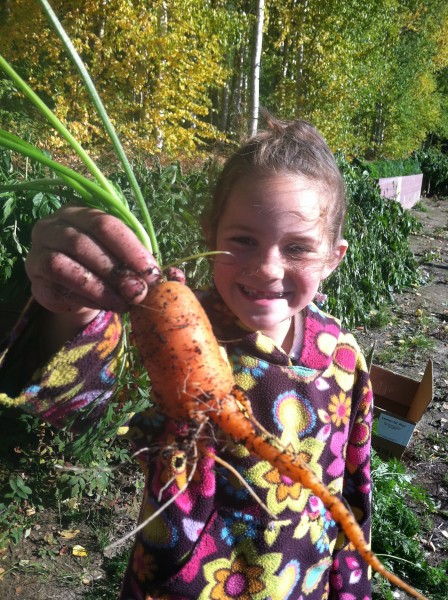Two Rivers School grows agriculture, horticulture and habitat program
November 8, 2013

907-474-5042
11/8/13
When students and their families gathered at Two Rivers School for parent night this fall, potato soup and fresh carrots were on the menu. Without a doubt, the children knew where those vegetables came from.
As part of a “learning landscape” program, the entire school has been engaged in not only improving the look of their area but have also influenced the taste of what they and their neighbors eat. “We are feeding our own community one carrot at a time,” said Principal Lori Swanson.
With a grant from the Fairbanks Soil and Water Conservation District, the school focused not only on agricultural projects, but horticulture and general improvements to the habitat.
Last May students and teachers built four 4x12-foot planters, filled them with mulch and soil from local vendors and carefully planted carrots, soybeans and potatoes. By fall, the children had harvested 198 pounds of potatoes, 109 pounds of carrots and a tiny amount of soybeans. “The soybeans didn’t get very big,” Swanson said.
Local families purchased the veggies for a reasonable price. The rest was sold at the Tanana Valley Farmers Market with the funds designated for a field trip to Denali National Park next spring so the students can learn more about ecology and the environment. Enough seeds were saved to repeat the project next year.
Middle school teacher Todd Denick said, “We have a unique environment here at Two Rivers School and we believe it is important to utilize our resources for the benefits of our students.” Middle school students worked closely with the kindergartners and first graders during the harvest. Denick took advantage of the learning opportunities by having the students organize, weigh and average the produce in order to emulate a real life experience. Many of the students participated in the entire process including harvesting, storing, selling, cooking and eating.
“When we begin a project our real hope is to instill in our students a sense of responsibility,” Denick said. “Our school can offer so much to the community outside of our educational pursuits. We have the soil, we have compost, we have seeds and we have the dedicated families to help us continue this project for the coming years.”
Denick recently completed the Master Gardener course and was able to use that new knowledge to work with the children. “The students were ecstatic to get their hands dirty,” he said. “For many of the students, gardening is part of their lifestyle and being able to share the information that they have gathered over their experiences during the summer were beneficial for those who may not have had those experiences. I have never seen the students so interested in trying the produce. It was especially satisfying to watch them try soybeans, which was a new experience for many of them.”
At the school’s harvest dinner, the students were excited to see the full food cycle take place before their eyes, Denick said.
In addition to growing food crops, the students planted iris bulbs around the soccer fields, creating a rain garden. They also planted 30 trees and shrubs along a nature trail and installed nesting boxes for birds. They even have a designated pollinator garden. Everything from the design to the hands-on work involved the students. “It took teamwork,” Principal Swanson said. “Our goal is to pick small projects we can complete so the kids can be proud of their work.” One future project in the works is to install student-created interpretive signs throughout the grounds.
“We’re out in the country and have access to different things than other schools,” Swanson said. “We can use gardening and the outdoors for science activities. We’ll plant different things next spring; it’s a work in progress.”
Joni Scharfenberg of the Fairbanks Soil and Water Conservation District said she works with the U.S. Fish and Wildlife Service Schoolyard Habitat program. “The motives are for restoration and to get kids outside and learning about their natural surroundings,” Scharfenberg said. “We brought lessons into the classrooms and outdoors. Getting outdoors helps kids utilize real life applications for learning and they have so much fun planting.
“The kids are the future stewards of the land and we are a natural resource state, which will be in their future care, so it’s important for them to learn about natural resources,” Scharfenberg said.
Learn more about Schoolyard Habitats at http://www.fws.gov/alaska/fisheries/restoration/schoolyard_habitat.htm.
This column is provided as a service by the UAF School of Natural Resources and Agricultural Sciences and the Agricultural and Forestry Experiment Station. Nancy Tarnai is the school and station’s public information officer.


